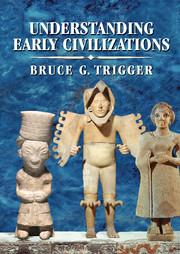Book contents
- Frontmatter
- Contents
- List of Illustrations
- Preface
- Understanding early civilizations
- Introduction
- Sociopolitical organization
- Economy
- Cognitive and symbolic aspects
- 19 Conceptions of the Supernatural
- 20 Cosmology and Cosmogony
- 21 Cult
- 22 Priests, Festivals, and the Politics of the Supernatural
- 23 The Individual and the Universe
- 24 Elite Art and Architecture
- 25 Literacy and Specialized Knowledge
- 26 Values and Personal Aspirations
- 27 Cultural Constants and Variables
- Discussion
- References
- Index
27 - Cultural Constants and Variables
Published online by Cambridge University Press: 05 June 2014
- Frontmatter
- Contents
- List of Illustrations
- Preface
- Understanding early civilizations
- Introduction
- Sociopolitical organization
- Economy
- Cognitive and symbolic aspects
- 19 Conceptions of the Supernatural
- 20 Cosmology and Cosmogony
- 21 Cult
- 22 Priests, Festivals, and the Politics of the Supernatural
- 23 The Individual and the Universe
- 24 Elite Art and Architecture
- 25 Literacy and Specialized Knowledge
- 26 Values and Personal Aspirations
- 27 Cultural Constants and Variables
- Discussion
- References
- Index
Summary
The collective identity of each early civilization was expressed by a distinctive and highly elaborated upper-class culture that formally symbolized that civilization's unity and differentiated it from neighbouring societies. The patronage of these elite traditions helped to distinguish the upper from the lower classes while identifying the upper classes with the civilization as a whole. Each early civilization possessed its own religious beliefs, myths, and festivals and its own distinctive style(s) of art, architecture, music, and dance. The most ambitious forms of conspicuous consumption in early civilizations were the sponsorship by rulers and the upper classes of the production of monumental architecture and high-quality works of art. The deployment of large amounts of lower-class labour to erect buildings that became symbols of upper-class dominance constituted further evidence of the power of the upper classes.
In territorial states, the culture of rural dwellers was regionally variable, while that of the upper classes was statewide and unitary. In city-state systems, local variants of the elite culture frequently distinguished one polity and its leaders from another, while pancivilizational similarities signalled the shared membership of the upper classes in a broader upper-class interaction network. There were, however, differences in the extent to which upper-class traditions were distinguished from those of commoners. In city-state systems, especially those that lacked a hereditary nobility, high-quality art tended to be a technically superior and aesthetically more sophisticated version of commoner art, while in territorial states it developed radically different canons and was produced by artists working full-time for the state rather than simultaneously for upper-class patrons and the marketplace.
Information
- Type
- Chapter
- Information
- Understanding Early CivilizationsA Comparative Study, pp. 638 - 650Publisher: Cambridge University PressPrint publication year: 2003
